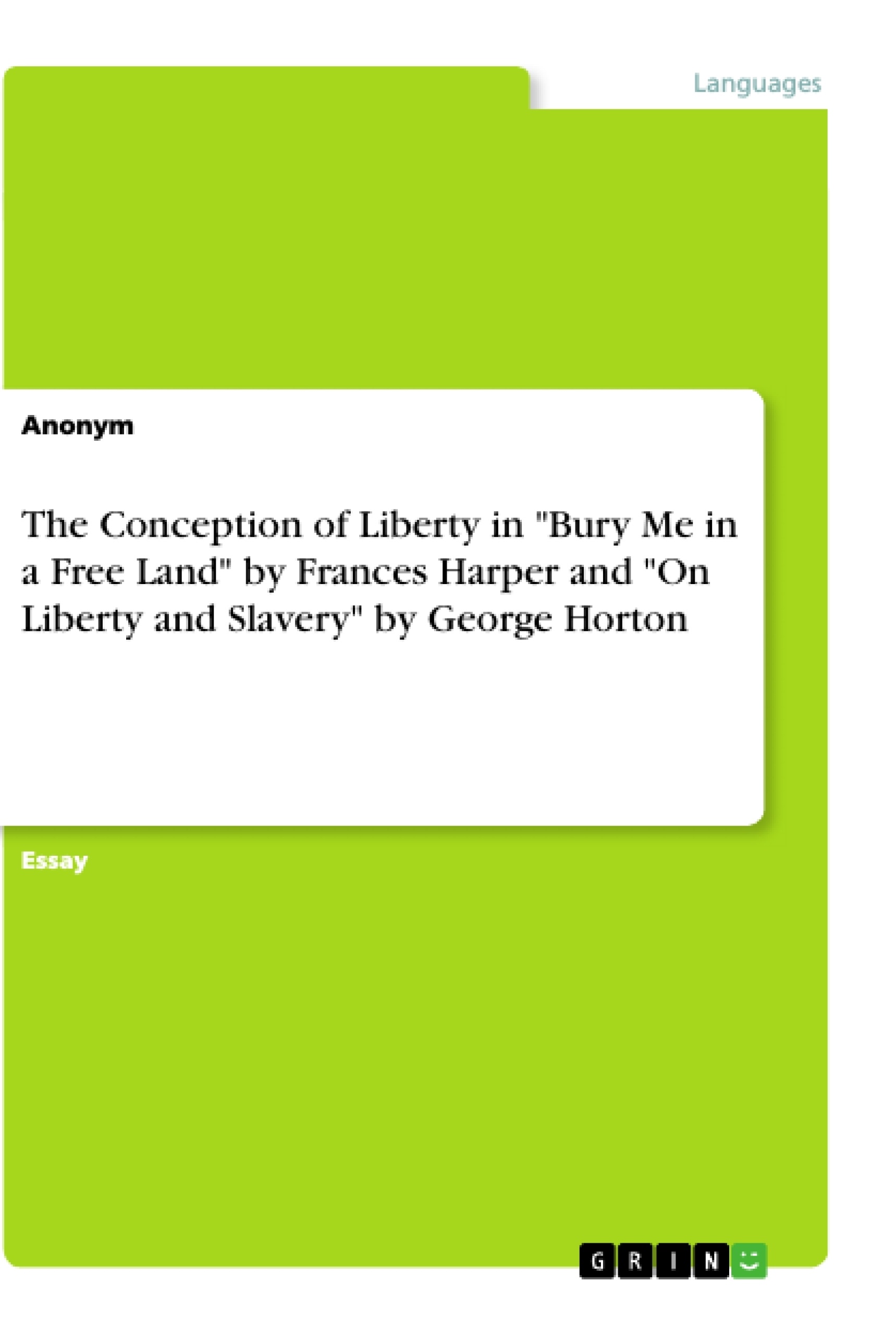This essay is going to discuss two poems: "Bury Me in a Free Land" by Frances Ellen Watkins Harper, published in 1858 and "On Liberty and Slavery" by George Moses Horton, published in 1829.
Both poems portray the topic of slavery and the associated desire of liberty. However, the two poems differ regarding their conception of liberty; Harper's conception is a general national one whereas Horton's is influenced by his own experiences as a slave.
Table of Contents
- Comparison of ‘Bury me in a free land' and ‘On Liberty and Slavery’
Objectives and Key Themes
This essay compares and contrasts two poems, "Bury Me in a Free Land" by Frances Ellen Watkins Harper and "On Liberty and Slavery" by George Moses Horton, both addressing the theme of slavery and the yearning for liberty. The analysis explores the distinct conceptions of liberty presented in each poem and examines the poetic techniques used to convey the experiences of slavery and the desire for freedom.
- The contrasting conceptions of liberty in Harper's and Horton's poems.
- The poetic techniques employed by each poet to express the theme of slavery.
- The emotional impact and evocative language used in both poems.
- The portrayal of the suffering of enslaved individuals, particularly women and their families.
- The use of metaphor and symbolism to convey the dehumanization of slavery.
Chapter Summaries
Comparison of ‘Bury me in a free land' and ‘On Liberty and Slavery’: This essay analyzes two poems addressing slavery and liberty: Frances Ellen Watkins Harper's "Bury Me in a Free Land" (1858) and George Moses Horton's "On Liberty and Slavery" (1829). Harper's poem, a protest against slavery, depicts the suffering of a deceased individual unable to find peace due to the ongoing institution of slavery. She employs a simple aabb rhyme scheme and mostly anapestic trimeter, using emotive language and metaphors to convey the brutality and dehumanization of slavery, particularly focusing on the suffering of Black women and mothers separated from their children. Horton's poem, based on his personal experience as a slave, uses a regular abab rhyme scheme and iambic tetra- and trimeter, showcasing a shift in tone from despair to hope. The analysis delves into the poetic techniques and thematic differences between the two poems, exploring how each poet expresses the complex realities of slavery and the profound desire for freedom. It examines the use of imagery, symbolism (such as doves representing freedom), and the impact of tone and structure on conveying the poems' messages. The contrasting approaches reveal how personal experience and broader social commentary intersect in articulating the theme of freedom.
Keywords
Slavery, liberty, freedom, Frances Ellen Watkins Harper, George Moses Horton, poetic techniques, metaphor, symbolism, emotional impact, Black women, dehumanization, antebellum, hope, despair.
Frequently Asked Questions: A Comparison of "Bury Me in a Free Land" and "On Liberty and Slavery"
What is the main focus of this essay?
This essay compares and contrasts two poems, "Bury Me in a Free Land" by Frances Ellen Watkins Harper and "On Liberty and Slavery" by George Moses Horton. Both poems address the theme of slavery and the yearning for liberty, exploring their distinct conceptions of freedom and the poetic techniques used to convey the experiences of slavery and the desire for freedom.
What are the key themes explored in the essay?
The essay explores the contrasting conceptions of liberty in both poems, the poetic techniques employed to express the theme of slavery, the emotional impact and evocative language used, the portrayal of suffering of enslaved individuals (especially women and their families), and the use of metaphor and symbolism to convey the dehumanization of slavery.
What are the key differences between Harper's and Horton's poems?
Harper's "Bury Me in a Free Land" uses a simple aabb rhyme scheme and anapestic trimeter, focusing on the suffering of Black women and mothers separated from their children due to slavery. Horton's "On Liberty and Slavery," based on his personal experience, uses an abab rhyme scheme and iambic tetra- and trimeter, showcasing a shift from despair to hope. The essay examines the distinct use of poetic techniques and thematic differences to understand how personal experiences and broader social commentary shape their expression of freedom.
What poetic techniques are analyzed in the essay?
The essay analyzes the use of imagery, symbolism (like doves representing freedom), rhyme scheme, meter, tone, and structure in both poems. It explores how these techniques contribute to conveying the poems' messages about slavery and the desire for freedom.
What is the overall conclusion of the essay?
The essay concludes by examining how the contrasting approaches of Harper and Horton, through personal experience and broader social commentary, intersect in articulating the complex theme of freedom during the antebellum period.
What are the keywords associated with this analysis?
Keywords include: Slavery, liberty, freedom, Frances Ellen Watkins Harper, George Moses Horton, poetic techniques, metaphor, symbolism, emotional impact, Black women, dehumanization, antebellum, hope, despair.
What is included in this language preview?
This preview offers a comprehensive overview including the title, table of contents, objectives and key themes, chapter summaries, and keywords.
- Quote paper
- Anonym (Author), 2018, The Conception of Liberty in "Bury Me in a Free Land" by Frances Harper and "On Liberty and Slavery" by George Horton, Munich, GRIN Verlag, https://www.grin.com/document/492609




